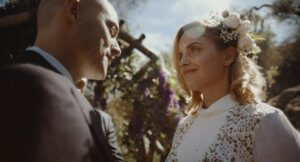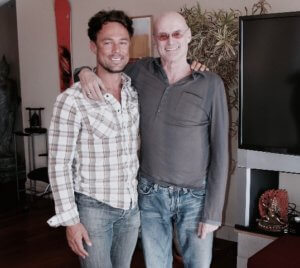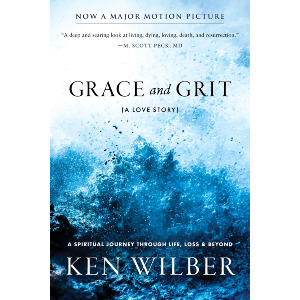Grace and Grit stars Mena Suvari and Stuart Townsend with Frances Fisher, Rebekah Graf, Nick Stahl, Lydia Hearst, and Mariel Hemingway.
Written & directed by Sebastian Siegel. Scroll down to read more about the making of Grace and Grit and adapting the book to film!
Visit graceandgrit.net for more information about the film.
Watch the Teaser
Praise for the Film
“I come from a tradition, Vedanta, where you start to go from waking, dreaming, sleeping, transcendent consciousness, cosmic consciousness, divine consciousness, ultimately to enlightenment or unity consciousness. This film [GRACE AND GRIT] mirrors these stages; mirrors the earlier stages of physical attraction, then infatuation, and then communion, not just connection but sacred communion. It goes on to extreme vulnerability and intimacy, and then surrender, and then passion—a very interesting kind of passion with all the masculine and feminine archetypes coming together and turns into ecstatic moments of physical ecstasy, mythical ecstasy, sacred ecstasy, yet it does end with transcendence . . . I’m now at a stage where I’m just tipping over the dark night of the soul, and this film has been very good for me because there’s a fine edge between existential despair and then suddenly liberation—so thank you for doing this film.” —Deepak Chopra
“Grace and Grit is an epic love story. Sebastian’s adaptation of this powerful book stays true to the source . . . this movie is a testament to the transformative powers of love.” —Marianne Williamson
“GRACE AND GRIT is visual and emotional poetry. The incredible original score by Kim & Kathryn Kluge (Scorsese’s SILENCE) is a perfect meld. It’s an emotional roller coaster. This film leaves you feeling that love is the alpha and the omega.” —Behind The Lens
A Note from Writer-Director Sebastian Siegel on the Making of Grace and Grit and Adapting the Book to Film
It’s an early December morning in 2012. I’m writing film notes in my hardcopy of Grace and Grit at a coffee shop in Honolulu, Hawaii, while birds chirp a song signifying the dawn. I’ve read almost all of Ken Wilber’s books, we’ve sat eye to eye in deep discussion at his home in Colorado, I’ve listened to hours of him speaking—and all this long before I took on adapting his powerful story to screen.
“What are you reading?” the barista says. I show her. “What’s it about?” she asks.
“It’s an epic tale of courage, compassion, identity, transcendence, and love beyond life.”
“Wow, I gotta read that,” she replies. “I’m reading The Girl with the Dragon Tattoo. It’ll probably be better than the movie.”
“This book is being made into a movie as well,” I say. She looks over at the title again as she brews my decaf dark black Kona coffee.
“Like Titanic, The Notebook, Love Story, or—did you see The Fountain?”
“Exactly,” I reply. “Though I tend to refrain from comparing a movie to a book. They’re different mediums of storytelling not meant to compete with one another. A book conveys concepts while allowing your imagination to fill in details, whereas a film adaptation, with constraints of time and demands for visual specificity, must make concrete statements with its form and often shrewd decisions about what to leave in and what to leave out. A film adaptation should supplement a book, not supplant it.”
When I first read Grace and Grit, it shook me. I couldn’t stop thinking about it. Then I read about how others around the world felt the same way, that this story offered some sort of hope about life, that it perhaps conveyed a meaning about what we are ultimately doing here. The book left me in tears, yet somehow inspired. I felt that Ken and Treya’s story epitomized what was possible with romantic, courageous, compassionate, fearless, and, ultimately, selfless love. It marked a standard for relationship that I already intuited was alive within me, yet that I still wished to experience in this lifetime. When I turned the last page and set the book down, I did not know that I would subsequently spend a decade to make it into a film. I did not choose to tell this story; somehow, it chose me. The book left me with a feeling, a feeling of being shattered and yet simultaneously full of hope. I felt that there was a cord woven through the universe that resounded with truth and beauty, and that echoed beyond life. It gave me the sense that if I could experience and resonate with it, then maybe, in this life—through loving—I could also participate in this sacred something that reaches beyond. There is an intuition that speaks to us through love, one that guides our actions to do things that we may not otherwise equate as being sensible. It’s a transrational sense. And when we heed it and are willing to surrender to its calling—when we are courageous, selfless, and trust in that omega point-pull to evolve—we can let love guide us, even shatter us, so that in the end it may transform us.
WHEN I TURNED THE LAST PAGE AND SET THE BOOK DOWN, I DID NOT KNOW THAT I WOULD SUBSEQUENTLY SPEND A DECADE TO MAKE IT INTO A FILM. I DID NOT CHOOSE TO TELL THIS STORY; SOMEHOW, IT CHOSE ME.
I’ve been meditating for twenty years. I’ve had a book published on consciousness and transcendence. I’ve written, produced, and directed a number of projects and been a storyteller my entire life. Yet adapting this book to film was a calling of emotional, intellectual, and sacrificial dexterity that would—by the necessities of the filmmaking process—demand requisites of both equanimity and relentless dedication and initiative. Moreover, some aspect of every story that gets adapted to film must get distilled. How can I, after having been rocked by lightning numerous times through thousands of pages of Ken Wilber writings—especially if I want the film to subtly convey his work as he was influenced during this catalytic and deeply personal period of his life—attempt to distill any part of his voice that powerfully proclaims the faults of reductionism? The irony. The paradox. The hilarity.
I think of this film in some way as a poem. It’s a love letter. My aim has been for it to seduce you into a state where you get lost in time. I want you to fall in love with these two beings, fall with them, laugh with them, taste the irony and feel the unfairness. I want you to experience hope and letdown, to renew the subtleties of your own sentience out of adoration for this fleeting yet spectacular instant of life, and to rediscover the knowledge that it will leave you—that the goodbyes of your own self are inevitable, yet that your place in your greater Self is alive, here and now, forever. Part of my particular mission as a filmmaker, and duty here as a storyteller, has been to extrapolate upon perennial themes—to suggest that we may touch that eternal Self by bearing witness to the beauty and fragility of life, and by sanctifying it through celebrating love.
A film adaptation is only a map, of a map, of a map of a territory. It will never carry the specificity or replicate the terrain of the original experience. Illness is an integral element of the book and, of course, a plot point in the film. However, it’s not the crux of the story. This story is about love. It’s one remarkable woman’s journey of courage and, ultimately, transcendence. It’s the willingness of two beings to let us into their minds and their hearts, their victories and their faults, to allow us to witness what’s possible with compassion and sacrifice and through letting go to hold on. It’s a testament to the transformative alchemy of love. My mission has been to echo its heartbeat, to pay forward in resonance the impact of the original story. It took ten years to paint on screen a journey that endured for five and that, as an end product, takes only one hour and fifty minutes to watch (unless you’re a die-hard Wilber reader and seek out an extended director’s cut for later release, which will include about thirty minutes of additional footage). One of the aspects I adore about Grace and Grit is that it articulates, through Treya and Ken’s journey, the evolutionary drive toward greater complexity, greater wholeness, and greater consciousness. We see them meet, fall, grow, transform, and deepen. Books, music, and movies may help us to feel and recognize that drive within ourselves—our own impulse to forgive, to be compassionate, and to adventure outward into the unknown. This is why I became a storyteller, a writer, a filmmaker. The uniquely immersive capacity of film can elicit profound state experiences that may act as gateways for the progression of our development. On occasion a book or a movie may move us to make a change, take an action, or simply open us up to a new paradigm or perspective.
MY MISSION HAS BEEN TO ECHO ITS HEARTBEAT, TO PAY FORWARD IN RESONANCE THE IMPACT OF THE ORIGINAL STORY.
I could have achieved making Grace and Grit into a film at an earlier date, but not in ways where I would have felt creatively comfortable in honoring both their story and Wilber’s celebrated voice on the subject of transcendence. In adapting this highly original book to film we unpack the narrative through three realms: the real world, in dreams, and by the expression of our characters’ intuition (waking, dreaming, deep sleep—or gross, subtle, causal). They’re drawn to each other, they fall in love, they go beyond. I wanted to make this picture a sumptuous visual experience for audiences. I prepped each scene to shoot through particular lenses in beautiful settings, using many long single shots for fluidity and intimacy, and to underscore and juxtapose the internal complexities of the characters’ arching relationships. I mapped out the story in three essential chapters, each being framed by distinctly different backgrounds, colors, and styles to match what our characters are going through. Their primary homes begin with Treya’s in Muir beach, a feminine home that’s richly fertile. Their second home in Lake Tahoe—where they try to force things to work—is entirely angular, geometric, and efficient. Their brief stay in Germany is tinted with hues of blue and orange, and their third and final home in Boulder, Colorado, is thick with rich woods built into every space—the echo of life beyond woven into the world around them. The color palette and style is particular for each location and character, and progresses through each act marking pivotal successions of unfolding—from the subtle hues of purple that adorn Treya’s character and the development of her artworks and writing to the glasses and books present around Ken’s character.
After we completed the film, over six years after making those initial notes on the screenplay, I found myself back at that coffee shop in Hawaii. It was around sundown now; the sky was glowing pinkish-orange and different birds carried that same song, this time inviting dusk. In those years that flew by, something had changed, and yet something had remained exactly the same. And then I heard a familiar voice . . . that barista whom I had had a discussion with in what seemed like just an instant ago.
“Hey! I read the book and it rocked my soul. I can’t wait to see the film! Thank you. And I promise, I won’t compare the two. I’ll just let it take me where it does.”
I hope that you will read this book, see the film (once it is married to the right distributor that will best support it), and that this inspiring true story may further cultivate the deeply existing capacity for all aspects of passionate, profound, and selfless love in your own being. Its translation has been worth the price of the candle for me. It’s been an act of service to both Treya and Ken, and to love itself. I hope it may stir the wisdom of your transrationale—the knowing within, beneath, and beyond yourself—and that it may inspire you to trust your intuition, to let love move you, and to draw you even more deeply into your own journey of self-actualization and becoming. This book, and all of Ken’s writing, does that for me. His work provokes awe. It prompts reawakening. Reading his work invites a type of spectacular understanding that paints the world anew with rich textures on dynamic maps that we are both experiencers in and designers of. With Shambhala’s re-release of a special edition of Grace and Grit in 2020 in anticipation of the movie, I hope this film will both support the legacy of Wilber’s writing and—as the book has—inspire audiences around the world to have the courage to love fearlessly. In however many moments we may have left, may we find something good, something true, and something beautiful.
Sebastian Siegel



About the Writer-Director

Praise for Sebastian Siegel's Work
“Sebastian Siegel draws insights into the beauty and complexities of the human condition with an inspiring and original voice.”—Marianne Williamson
“Siegel makes the language go all the way to a place it cannot go, and winds up pointing to a kind of mystery, deep within, far without, but real as he contends it is. I found myself wondering: where did these words come from—the writer, the seducer of spirit?”—George Tanabe, former Chairman, Dept. of Religions, University Hawaii (specialty in Buddhism)
"Like The Tree of Life or The Fountain, Grace and Grit is a movie that takes you on a spiritual journey into the depths of love, and then beyond. Sebastian Siegel is a dexterous and original director, his movie is transcendent storytelling at its best.”—Alex Grey, Founder of CoSM
“This film stays with you, it grabs you. Both lead actors give Oscar worthy performances. Mena Suvari’s revelatory performance is haunting me days later. Siegel’s work feels expansive and creative. It’s not just incredibly intimate . . . it’s open and raw.”—Julia Ormond
"Like the book it’s adapted from, this film is brilliant. Grace and Grit will shake you, and maybe even awaken you in some way. This movie is a must-see, especially for anyone interested in love or consciousness.”—John Mackey, Founder of Whole Foods
“Siegel has transformed the original book into an effortless masterpiece.”—BASIC Magazine
Media Links
Film Production Interview with Sebastian Siegel
Learn more about the movie at www.GraceAndGrit.net

